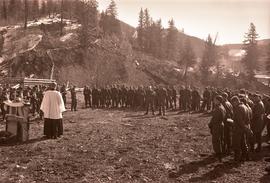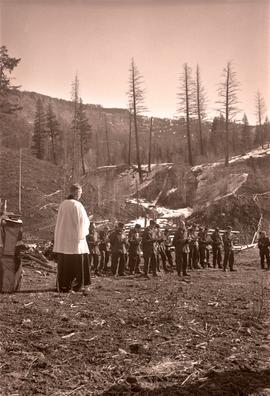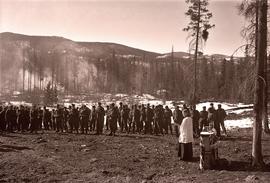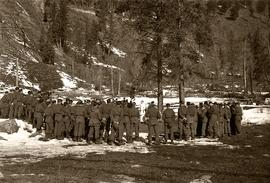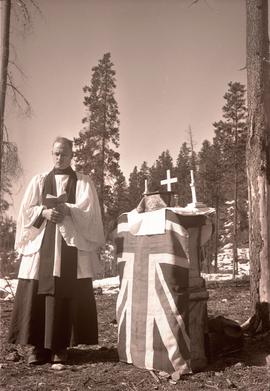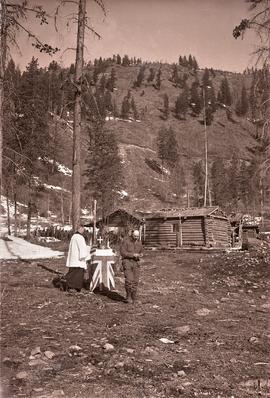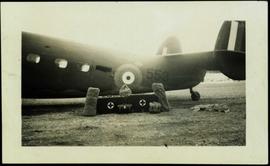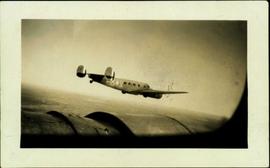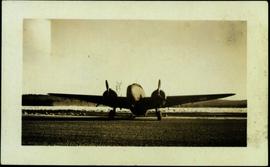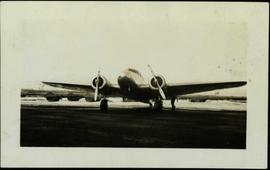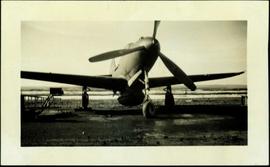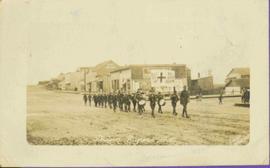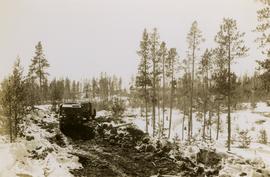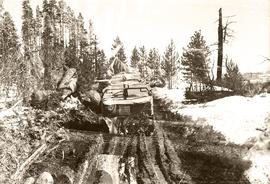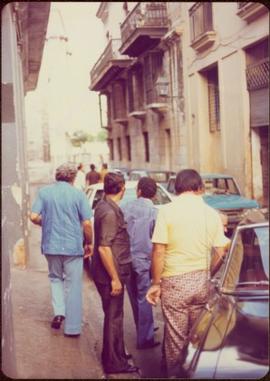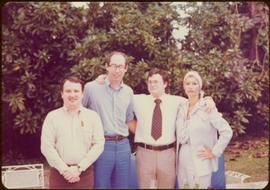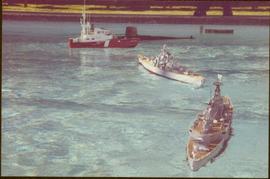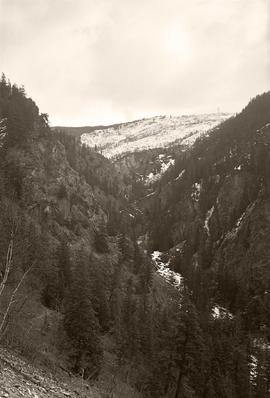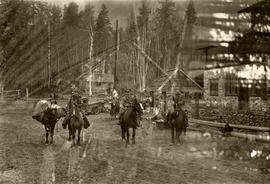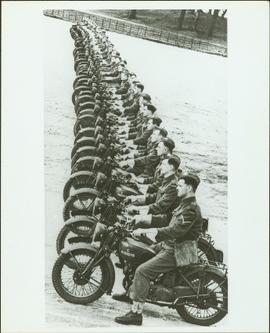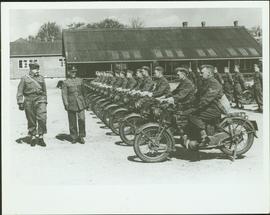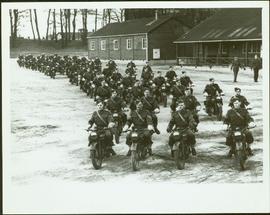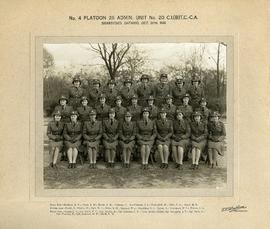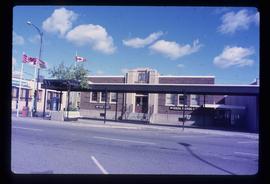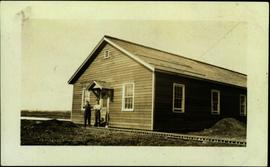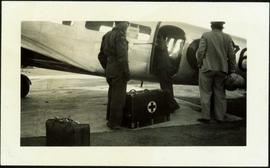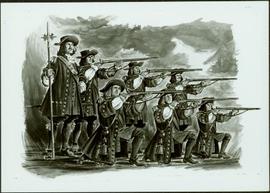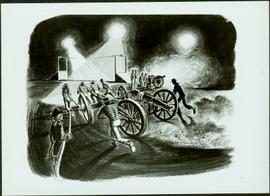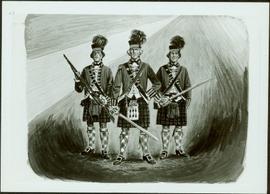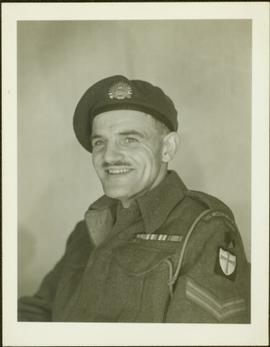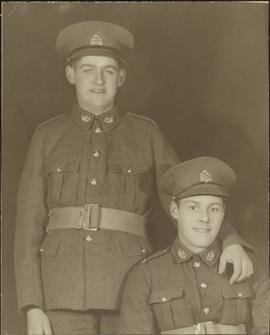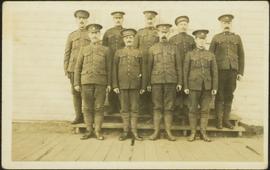Photograph depicts a military chaplain reading by a makeshift altar to a large group of soldiers, likely somewhere between Bella Coola and Anahim Lake during the WWII Polar Bear training exercise.
Photograph depicts a military chaplain reading by a makeshift altar to a large group of soldiers, likely somewhere between Bella Coola and Anahim Lake during the WWII Polar Bear training exercise.
Photograph depicts a military chaplain reading by a makeshift altar to a large group of soldiers, likely somewhere between Bella Coola and Anahim Lake during the WWII Polar Bear training exercise.
Photograph depicts a military chaplain reading by a makeshift altar to a large group of soldiers, likely somewhere between Bella Coola and Anahim Lake during the WWII Polar Bear training exercise.
Photograph depicts a military chaplain reading by a makeshift altar to a large group of soldiers, likely somewhere between Bella Coola and Anahim Lake during the WWII Polar Bear training exercise.
Photograph depicts a military chaplain reading by a makeshift altar with the Union Jack flag, likely somewhere between Bella Coola and Anahim Lake during the WWII Polar Bear training exercise.
Photograph depicts a second military chaplain reading by a makeshift tree stump altar, likely somewhere between Bella Coola and Anahim Lake during the WWII Polar Bear training exercise.
Photograph depicts a military chaplain standing by a makeshift altar with a cabin and group of soldiers in background, likely somewhere between Bella Coola and Anahim Lake during the WWII Polar Bear training exercise.
File consists of four nametags and a rope connecting 3 of the 4 nametags with the title "Lieut. B. Schenk UNC CDN". Object originally stored in a box labelled: "Patches and flashes from A.B.'s uniform".
Photograph depicts a military plane with the number "553" on its side. Medical equipment, and various other supplies are laid on ground in front of plane. Handwritten photo album caption below this photo reads: "351 lbs of Equipment."
Royal Canadian Air ForcePhotograph depicts a military plane in flight with the number "7634" on its side. As the photo was taken through the window of a second plane in flight, the outline of the window is visible, as is the left engine. Handwritten photo album caption below this photo reads: "Our Travelling Companion, '34' at 10 000 feet."
Royal Canadian Air ForceHandwritten photo album caption below this photo reads: "Everybody gone to Breakfast." Photograph depicts plane from front view sitting in airstrip. Snow-covered field and trees in background.
Royal Canadian Air ForcePhotograph depicts military plane landed in Grande Prairie airstrip. One man is semi-visible behind left wing. Land rollers, other unidentified equipment, and flat horizon in background. Handwritten photo album caption beside this photo reads: "32".
Royal Canadian Air ForceHandwritten photo album caption below this photo reads: "P '39'". Photograph depicts view of plane from front parked in airstrip believed to be at Whitehorse. Ladder, hose, and unidentified objects in left foreground. Snow and horizon in background.
Royal Canadian Air ForceHandwritten photo album caption below this photo reads: " 'Parked For The Night.' C.P.A. [Locheed ?] at Ft. Nelson." Photograph depicts military plane in runway, its engines draped and enclosed in tarp covering. Steel drums and hose on trailer pulled by tractor in foreground, as well as movable staircase. Trees on horizon in background.
Royal Canadian Air ForceFile consists of WWII military service ephemera, including a German language book for service personnel, a certificate of registration for firearms, and a discharge letter.
Parade of uniformed marchers with sign that reads: “Every little helps, Do your share” (with a large cross). Buildings on street in background. Printed annotation on recto reads: “Prince Rupert B.C.” Handwritten annotation in pencil on verso reads: “Prince Rupert B.C.”
File consists of a metal cufflink possibly used in the Canadian military. Object originally stored in a box labelled: "Patches and flashes from A.B.'s uniform".
File consists of a pocket flap military uniform accessory with two button holes. Object originally stored in a box labelled: "Patches and flashes from A.B.'s uniform".
File consists of a military uniform metal accessory possibly used by the Canadian military. Object originally stored in a box labelled: "Patches and flashes from A.B.'s uniform".
File consists of a leather and metal strap, presumably related to military uniform. Object originally stored in a box labelled: "Patches and flashes from A.B.'s uniform".
Photograph depicts two military vehicles traversing a rough dirt road between Bella Coola and Anahim Lake during the WWII Polar Bear training exercise.
Photograph depicts two military vehicles traversing a rough dirt road between Bella Coola and Anahim Lake during the WWII Polar Bear training exercise. The vehicle at the back of the convoy is marked with a notice: "CAUTION - RIGHT HAND DRIVE - NO SIGNALS".
Photograph depicts two military vehicles traversing a rough dirt road between Bella Coola and Anahim Lake during the WWII Polar Bear training exercise.
The group stands in narrow street lined with cars.
Handwritten annotation on verso reads: “Jan 78 - Havana Cuba, Chuck + Secret Service”.
Photograph taken during a Ministry of Sport Tour in Cuba, 1977 - 1978. See also items 2009.6.1.198 - 2009.6.1.224.
Lawn chairs and trees in background. See item 2009.6.1.220 for image featuring similar content.
Handwritten annotation on verso reads: “my campanero’s de Havana, Jan./78, Ian Howard, Executive Assistant; Roger Jackson, Director Sport Cda; Eric Morse, Ext. Affairs (Spy)”.
Photograph taken during a Ministry of Sport Tour in Cuba, 1977 - 1978. See also items 2009.6.1.198 - 2009.6.1.224.
File consists of photographs pertaining to Bertha Schenk and her experience during World War II.
This file consists of 79 photographs, various postcards and Christmas cards from the Royal Irish Constabulary; “Old Hand remembers early days” (unidentified newspaper article re: Burnaby detachment of BC Provincial Police); and a magazine clipping featuring a group photo of “Officers of the B.C. Police, April 1930.” General subjects areas identified in the photographs include: Toc H (Kelowna); the Royal Irish Constabulary; the British Columbia Provincial Police; the Royal Canadian Mounted Police; 1945 liberation parade in Amsterdam, Holland; various historical regimental artworks; badges, helmets, ornaments, banners and related constabulary ephemera; and Claxton in his New Westminster store "Roderick Jewelers" with his extensive collection of constabulary related materials.
File consists of two miscellaneous metal pieces. Object originally stored in a box labelled: "Patches and flashes from A.B.'s uniform".
Photograph taken at outdoor function, see also items 2009.6.1.629 - 2009.6.1.634.
Handwritten annotation on verso reads: “model ships in G.H. Pool to honour BC Based H.M.C.S. (Esquimalt) + Admirals”.
Photograph depicts a narrow mountain gorge between Bella Coola and Anahim Lake during the WWII Polar Bear training exercise.
Photograph depicts a three mounted soldiers with a pack horse in front of a stone building, possibly somewhere between Bella Coola and Anahim Lake during the WWII Polar Bear training exercise. Another man and a woman stand in the background near a truck and a flagpole.
Subseries consists of correspondence and accompanying informational material related to the Department of National Defence and national security issues in general. Records include newspaper clippings, newsletters, press releases, brochures, and speeches by the Minister of National Defence. Includes correspondence regarding Operation Morninglight, CFS Masset, Katimavik, aircraft, the role of women in the Canadian Forces, and the proposed closing of Wolseley Barracks.
Photograph depicts the Canadian Provost Corps in motorcycle formation. Handwritten annotation on verso reads: "No. 1 Provost Coy, England 1940". Stamped annotation on verso reads: "[--]egative No. 727-1. Please quote when reordering."
Photograph depicts two unidentified officers inspect the first row of motorcycle corps members. Handwritten annotation on verso reads: "No. 1 Provost Coy, England 1940". Stamped annotation on verso reads: "[--]tive No. 5629. Please quote when reordering."
Photograph depicts the No. 1 Canadian Provost Corps riding in formation within camp compound. Two unidentified officers seen watching in the background. Stamped annotation on verso reads: "Negative No. 2043. [----] when reordering."
File consists of a group portrait photograph depicting Canadian Women's Army Corps (CWAC) No. 4 Platoon 26, Admin unit 20 C.I.(B)T.C.-C.A., Brantford, Ontario in 1944. These service members were likely completing their Canadian Infantry Basic Training at the Brantford, Ontario training centre.
Depicted are the following persons:
Back row: Bingham, S.M.; Jones, B.M.; Bowie, S.M.; Coleman, P.; VanSomeren, J.C.; Kastrukoff, M.; Dietz, P.A.; Allard, H.K.
Centre row: Szalak, I.; Martin, M.; Park, N.A.; Birks, Y.M.; England, T.E.; Glendillen, E.J.; Byrom, A.; Trenchard, M.L.; Haines, A.L.
Front row: Waschuk, A.; Cpl. Clark, E.L.; Cpl. Starkie, K.; Sgt. Dickman, C.M.; Lieut. Bertha Schenk; Sgt. Stevenson, J.Y.; Sgt. Dyck, A.; Cpl. Teasdale, E.; Cpl. Cameron, M.D.; Smith, L.M.
Image depicts the Canadian Forces Recruiting Centre on the north side of 3rd Ave in Prince George, B.C.
Handwritten photo album caption below this photo reads: “Officers' Quarters, Ft St John.” Photograph depicts two men standing in distance at doorway of officers' quarters, wood slat sidewalk in foreground. Fence and trees on horizon in background, dirt pile to right of building. The two men are believed to be Captain Read (2006.20.12.17) and the man in charge of general duties (item 2006.20.12.15).
Royal Canadian Air ForceFile consists of 7 bronze Order of the Bath pins which are given to members of the British and Commonwealth military. Object originally stored in a box labelled: "Patches and flashes from A.B.'s uniform".
Handwritten photo album caption below this photo reads: “Packing for home: ^Sick Indian.” Arrow is pointed at man facing plane and holding small bundle. Three other men in uniform stand with luggage in front of plane (one believed to be unidentified man from item 2006.20.12.18). A fifth man in suit is semi-visible, loading plane.
Royal Canadian Air ForcePhotograph depicts a painting of a battle regiment consisting of six men holding rifles and one man looking on. Typed annotation glued to verso of photograph reads: "Le Régiment de Carignan-Salières - 1665. This famous regiment was dispatched to Canada (then called New France) by King Louis XIV and disembarked from its small sailing vessels on eastern shores in the spring of 1665. Historically it was an important event. Until then, the colonists had been obliged to provide their own defence and the French regiment was the first military protection they enjoyed."; "Le Régiment de Carignan-Salières - 1665. Ce fameux régiment fut envoyé au Canada (appelé alors Nouvelle-France) par Louis XIV. Au printemps de 1665, il débarquait sur les rivages de l'est. Jusque-là, les colons avaient dû se défendre par leurs propres moyens; c'était la première protection militaire qui leur était offerte. L'arrivée des troupes régulières ramenèrent l'espoir aux colons découragés."
Photograph depicts a painting of a naval gun race with men in striped shirts pulling canons and an onlooking officer in uniform. Typed annotation glued to verso of photograph provides an interpretation of this piece of art: "Course de canons de la Marine. Deux équipes, en costumes de la Marine de 1812, réalisent une variante sensationnelle de la course de canons traditionnelle de la Marine. Elles doivent démanteler complètement les canons antiques, les porter en une course d'obstacles difficile et les réassembler pour faire feu. Il faut du courage, du muscle, et des mois d'entraînement."; "Naval gun race. Two teams in naval costumes of 1812 stage a thrilling variation on the traditional naval gun race. They must completely dismantle the antique cannons, carry them over a grueling obstacle course and reassemble the guns for firing. It takes courage, muscle and months of training."
Photograph depicts the a painting of three men in the Royal Highland military uniforms. Typed annotation glued to verso of photograph provides an interpretation of this piece of art: "The 42nd (Royal Highland) Regiment of Foot - 1782. The first battalion of this British regiment arrived in New York in 1756. After serving in numerous campaigns and engagements in North America, the 42nd (Royal Highland) Regiment of Foot garrisoned in Nova Scotia. It is from this famous regiment that the Black Watch (Royal Highland) Regiment of Canada derives its name and much of its colorful dress and traditions."; "Le 42nd (Royal Highland) Regiment of Foot - 1782. Le premier bataillon de ce régiment britannique arriva à New-York en 1756. Après plusieurs campagnes en Amérique du Nord, il fit garnison en Nouvelle-Ecosse. C'est de ce fameux régiment que s'inspirent les uniformes et les traditions du Black Watch (Royal Highland) Regiment of Canada. Cornemuses et tambours y ont toujours joué un rôle important et pittoresque."
File consists of photographs depicting team sports and military life during WWII.
Handwritten photo album caption below this photo reads: “Fort St John Apron. F/Rideouts 'Norseman'^" Arrow is pointed at plane on far right with the number "2466" on its side and unidentified equipment below. Runway in foreground, approximately four military planes in background surrounded with unidentified people and equipment.
Royal Canadian Air ForcePhotograph depicts a portrait of James Joseph Claxton in military uniform. Handwritten annotation on verso reads: “Jim Salmon Arm 1945”
Photograph depicts Sir Neville Chamberlain posed in full military attire. Photograph is most likely a copy print and/or a photograph taken of an image in a book or newspaper due to its extremely poor clarity. Handwritten annotation on verso reads: "Sir Neville Chamberlain, Inspector-General, R.I.C."
Photograph depicts two unidentified soldiers in uniform, one seated and the other standing behind.
Photograph depicts 9 soldiers posed in uniform on steps. Wooden boardwalk in foreground, side of building in background. Handwritten annotation on recto of photograph: "Like the Country over here but it is very wet at present have you been around the ranch lately, would have come home, but we had to leave in a hurry hope to see you all well when I come back how are the fruit trees looking, let me have all the news. Yours Truly [Pete?] G Williamson 63rd B Battalion No 464284 Army Post Office London England." Photograph speculated to have been sent to H.F. Glassey or his family.
